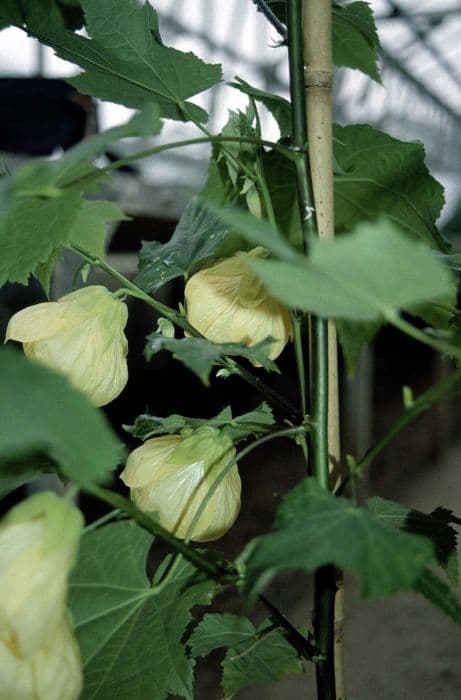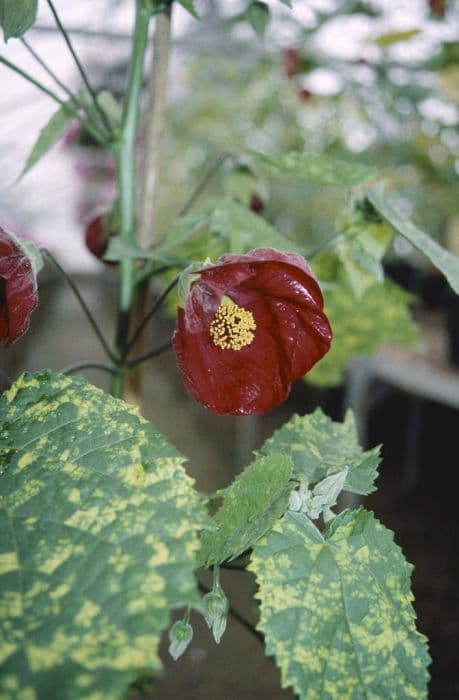Chilean Tree Mallow Corynabutilon vitifolium 'Tennant's White'

ABOUT
Corynabutilon vitifolium 'Tennant's White', commonly known as Chilean Tree Mallow, is a striking ornamental plant. It features a lush foliage of large, maple-like leaves that have a soft, velvety texture and a rich green color. The leaves are broad and lobed, creating a full, dense canopy. Its most remarkable aspect is the profusion of blossoms it produces. The flowers are a pure, glossy white, with a soft, satiny finish, and they dangle gracefully from the branches. Each flower has a bell-like shape with a delicate appearance, showcasing a subtle contrast with the bold leaves. The blooming period of the Chilean Tree Mallow is quite generous, adding to its appeal as a garden specimen. The plant overall creates a soft yet lush aesthetic, making it a favorite among gardeners who seek to add a touch of elegance and a cottage-like feel to their landscapes.
About this plant
 Names
NamesFamily
Malvaceae.
Synonyms
Chilean Tree Mallow, Mallow-Leaved Abutilon, Vine-Leaved Abutilon, Tennant's White.
Common names
Abutilon vitifolium (Cav.) C.Presl, Sida vitifolia Cav.
 Toxicity
ToxicityTo humans
The Chilean Bellflower, which is the most common name for Corynabutilon vitifolium 'Tennant's White', does not have a well-documented profile concerning its toxicity to humans. There is limited evidence to suggest standard symptoms or consequences of ingestion or contact. Always exercise caution and refrain from consuming any parts of ornamental plants unless they are known to be safe. If ingestion occurs and any adverse reactions are noted, medical attention should be sought.
To pets
Regarding pets, the Chilean Bellflower is not widely known for its toxicity. As with humans, there is a lack of substantial information regarding poisonous effects on animals. Pet owners should ensure that pets do not ingest parts of this plant as a precaution. In the event that a pet consumes the Chilean Bellflower and shows signs of illness, it is advised to consult a veterinarian immediately.
 Characteristics
CharacteristicsLife cycle
Perennials
Foliage type
Semi-deciduous
Color of leaves
Green
Flower color
White
Height
10 feet (3 meters)
Spread
6 feet (1.8 meters)
Plant type
Shrub
Hardiness zones
9
Native area
Chile
Benefits
 General Benefits
General Benefits- Aesthetic Appeal: This plant produces large, showy white flowers that enhance the beauty of gardens and landscapes.
- Pollinator Attraction: The flowers attract bees, butterflies, and other pollinators, supporting local biodiversity.
- Shade Tolerance: It can grow well in partially shaded areas, offering flexibility in garden design.
- Drought Tolerance: Once established, it is relatively drought-resistant, making it suitable for xeriscaping or water-wise gardens.
- Fast Growth: It is known for its rapid growth, allowing gardeners to enjoy its blooms relatively quickly after planting.
- Easy Pruning: The plant can be easily pruned to control its size and shape, which is ideal for maintaining a tidy appearance.
- Versatility: It can be used in various garden settings, including beds, borders, and as a specimen plant.
 Medical Properties
Medical PropertiesThis plant is not used for medical purposes.
 Air-purifying Qualities
Air-purifying QualitiesThis plant is not specifically known for air purifying qualities.
 Other Uses
Other Uses- Textile Dyeing: The mallow family, to which the Chilean tree mallow belongs, has species that have historically been used for natural dyes, and this plant could potentially offer similar properties.
- Photography: The flowers of the Chilean tree mallow reflect ultraviolet light, which can be used by photographers to create interesting UV fluorescence effects in artistic photography.
- Educational Tool: The plant can be used in botanical education to teach students about plant morphology and the diversity of the Malvaceae family.
- Artistic Inspiration: The striking white flowers and lush foliage of the Chilean tree mallow can be used as a subject for painting, drawing, and other visual arts.
- Sound Barrier: When planted in dense hedges, the Chilean tree mallow can serve as a natural sound dampener for traffic or neighborhood noise.
- Habitat Creation: The plant can offer shelter and nesting sites for small birds and insects within its dense branches.
- Privacy Screening: Due to its size and dense growth habit, Chilean tree mallow can be used to create living privacy screens in gardens and parks.
- Landscape Photography: The picturesque form and flowers of the plant make it a captivating feature in landscape photography.
- Erosion Control: The root systems can help stabilize slopes and prevent soil erosion in residential and public landscaping projects.
- Cultural Symbolism: The Chilean tree mallow could be adopted as a cultural or regional symbol for communities, illustrating local horticulture and biodiversity.
Interesting Facts
 Feng Shui
Feng ShuiThe Chilean bellflower is not used in Feng Shui practice.
 Zodiac Sign Compitability
Zodiac Sign CompitabilityThe Chilean bellflower is not used in astrology practice.
 Plant Symbolism
Plant Symbolism- Elegance - The delicate white flowers of the Chilean Bellflower represent sophistication and grace.
- Purity - White blooms often symbolize purity and innocence, which can be associated with this plant.
- Beauty in Simplicity - As the Chilean Bellflower has a simple yet striking appearance, it can symbolize the idea that beauty can be found in simple things.
- Tranquility - With its calming presence, the Chilean Bellflower can signify peace and tranquility.
- Adaptability - Being a plant that can grow in various conditions, it may represent the ability to adapt to different environments and situations.
 Water
WaterThe Chilean Bellflower should be watered deeply, ensuring the water reaches the plant's entire root zone. During the growing season, water approximately once a week, but always check the top inch of the soil for dryness before watering again. If the top inch is dry, it's time to water. Adjust watering frequency based on weather conditions—more frequently during hot, dry spells and less during cooler, rainy periods. On average, applying about 1 to 2 gallons of water weekly during the growing season should suffice, though this may vary with plant size and local conditions.
 Light
LightThe Chilean Bellflower thrives best in full sun to partial shade. The ideal spot for this plant is one where it receives at least 6 hours of direct sunlight but is also protected from the harsh afternoon sun. A position where it can enjoy morning sunlight and dappled afternoon shade would be perfect for balanced growth and flower production.
 Temperature
TemperatureThe Chilean Bellflower prefers a mild climate and does well in temperatures ranging between 50°F and 75°F. It is important to avoid exposing the plant to temperatures below 40°F, as it may not survive prolonged cold. Optimal growth and flowering occur within this temperature range, so consider these conditions when selecting a location for the plant.
 Pruning
PruningPrune the Chilean Bellflower to remove any dead or damaged growth and to maintain the desired shape of the plant. Pruning should be done in late winter or early spring before new growth begins. It's also beneficial to lightly prune after flowering to encourage a second bloom. Pruning can be done annually, timed with the natural growth cycle of the plant.
 Cleaning
CleaningAs needed
 Soil
SoilThe Chilean tree mallow thrives in well-draining, loamy soil with a pH ranging from slightly acidic to neutral (pH 6.0-7.5). A mix of two parts peat, one part perlite, and one part compost provides the ideal texture and nutrients for healthy growth.
 Repotting
RepottingThe Chilean tree mallow should be repotted every 2-3 years to refresh the soil and accommodate root growth. Repotting is best done in spring before new growth starts.
 Humidity & Misting
Humidity & MistingThe Chilean tree mallow prefers moderate humidity levels around 50-60%. It can tolerate lower humidity but may need extra care to prevent issues like leaf crisping.
 Suitable locations
Suitable locationsIndoor
Place the Chilean tree mallow in bright indirect light and keep it warm.
Outdoor
Grow the Chilean tree mallow in full sun to partial shade and shelter from strong winds.
Hardiness zone
9-11 USDA
 Life cycle
Life cycle'Tennant's White' Chilean Tree Mallow begins its life cycle when its seeds germinate in early spring, sprouting into seedlings in a warm and moist environment. As the seedlings grow, they develop into young plants with characteristic large, lobed leaves and a robust root system. Throughout the growing season, the plant undergoes vegetative growth, forming a woody base and multiple branches. By mid to late summer, it starts producing its showy white, hibiscus-like flowers that attract pollinators and may continue to bloom into the fall. After pollination, the flowers develop into dry fruit capsules containing seeds that, when mature, are dispersed by wind or gravity. In regions with mild winters, the Chilean Tree Mallow may behave as a perennial, surviving the cold season to regrow from its woody structure the following spring.
 Propogation
PropogationPropogation time
Spring-Early Summer
The most popular method of propagation for the Chilean Tree Mallow is via semi-ripe stem cuttings. This process typically begins in late summer. Cuttings of about 4-6 inches (10-15 cm) long should be taken from the current year's growth. It's important to choose healthy, non-flowering stems and to make a clean cut just below a leaf node. The lower leaves should be removed, and the cut end can be dipped in rooting hormone to encourage root growth. The prepared cutting is then placed in a pot filled with a mixture of peat and perlite or sand to provide good drainage. The cutting should be kept in a warm, humid environment but out of direct sunlight until roots have developed, which generally takes a few weeks.









![Rose of Sharon [Lavender Chiffon]](/_next/image?url=https%3A%2F%2Fplants-admin.emdemapps.com%2Fimages%2Fplants%2F%2Fimages%2F604b616c0ddec.png&w=640&q=75)